Quantitative Identification Study of Epidemic Risk in the Spatial Environment of Harbin City
Abstract
1. Introduction
2. Materials and Methods
2.1. Research Scale
2.2. Data Selection and Processing
2.2.1. Road Network Data and Point-of-Interest Data
2.2.2. Heat Map Data and Building Profile Data
2.2.3. Create Spatial Analysis Units
2.3. Research Methodology
2.3.1. Nuclear Density Analysis
2.3.2. Hot Spot Analysis
2.3.3. Space Network SDNA Analysis
2.3.4. Entropy Method
2.4. Functional Mix
2.5. Functional Density
2.6. Research Framework
3. Analysis of the Results
3.1. Quantification of Road Network Data Indicators
3.2. Quantification of Point-of-Interest Data Indicators
3.3. Quantification of Heat Map Data Indicators
3.4. Quantification of Building Profile Data Indicators
3.5. Outbreak Risk Identification and Validation
4. Discussion
5. Conclusions
Author Contributions
Funding
Institutional Review Board Statement
Informed Consent Statement
Data Availability Statement
Conflicts of Interest
References
- Fenxia, Z. The community resilience measurement throughout the COVID-19 pandemic and beyond-an empirical study based on data from Shanghai. Wuhan and Chengdu. Int. J. Disaster Risk Reduct. 2022, 67, 102664. [Google Scholar] [CrossRef] [PubMed]
- Wang, Z. How should education be transformed in the post-epidemic era? Res. Electrochem. Educ. 2020, 41, 13–20. [Google Scholar]
- Shao, P.P.; Shao, T.; Tang, S.F. Assessment of malaria risk likelihood weighted composite index method. China Public Health 2017, 33, 520–524. [Google Scholar]
- Li, M.; Liu, D.; Li, Z. Analysis of the spatial and temporal characteristics of China’s urban vitality recovery under the new crown epidemic. Mod. Urban Res. 2022, 1–7+15. [Google Scholar] [CrossRef]
- Li, X.; Zhou, L.; Jia, T.; Wu, H.; Zou, Y.; Qin, K. Influence of urban factors on COVID-19 epidemic—Wuhan city as an example. J. Wuhan Univ. (Inf. Sci. Ed.) 2020, 45, 826–835. [Google Scholar]
- Chen, X.; Huang, Y.J.; Li, J.; Wang, S.; Pei, T. Characteristics of spatial and temporal aggregation of COVID-19 epidemic and analysis of the influencing factors—Case study of Chongqing city. Adv. Geogr. Sci. 2020, 39, 1798–1808. [Google Scholar]
- Wang, J.; Du, D.; Wei, Y.; Yang, H. Study on the spatial diffusion process and pattern of the new crown pneumonia epidemic. Geogr. Res. 2020, 39, 1450–1462. [Google Scholar]
- Mo, C.; Tan, D.; Mai, T.; Bei, C.; Qin, J.; Pang, W.; Zhang, Z. An Analysis of Spatiotemporal Pattern for COIVD-19 in China based on Space-Time Cube. J. Med. Virol. 2020, 92, 1587–1595. [Google Scholar] [CrossRef]
- Desjardins, M.R.; Hohl, A.; Delmelle, E.M. Rapid surveillance of COVID-19 in the United States using a prospective space-time scan statistic: Detecting and evaluating emerging clusters. Appl. Geogr. 2020, 118, 102202. [Google Scholar] [CrossRef]
- Huang, X.; Fu, Y.; Zhang, J.; Yang, J.; Hong, J. Exploration of early spatial and temporal spread characteristics and public space risk of the new crown epidemic in Guangzhou City. Trop. Geomorphol. 2020, 41, 8–17. [Google Scholar]
- Xiang, Y. Risk evaluation and spatial pattern analysis of major infectious disease outbreaks in China. Disaster Sci. 2021, 36, 35–40. [Google Scholar]
- Wu, Q.; Qian, L.; Wu, Z. Research on spatial structure identification and spatial morphology of megalopolis based on multi-source data. Geomat. World 2020, 27, 32–38. [Google Scholar]
- Zhang, K.; Zhang, S.; Zhang, M.; Liu, X. Spatial characteristics of epidemic communities and “epidemic prevention circles” strategy in Wuhan. Disaster Sci. 2021, 36, 175–180+227. [Google Scholar]
- Qin, S.Y.; Zheng, X.; Chen, Y. Prevention and community management of COVID-19, an example of epidemic rebound in Harbin. Genom. Appl. Biol. 2020, 39, 3411–3415. [Google Scholar]
- Zeng, P.; Sun, Z.; Chen, Y.; Qiao, Z.; Cai, L. COVID-19: A comparative study of population aggregation patterns in the Central Urban Area of Tianjin, China. Int. J. Environ. Res. Public Health 2021, 18, 2135. [Google Scholar] [CrossRef]
- Yao, Y.; Shi, W.; Zhang, A.; Liu, Z.; Luo, S. Examining the diffusion of coronavirus disease 2019 cases in a metropolis: A space syntax approach. Int. J. Health Geogr. 2021, 20, 17. [Google Scholar] [CrossRef]
- Han, Y.; Yu, X.; Long, W. Functional area identification based on Beijing bus swipe card data and interest points. Urban Plan. 2016, 40, 52–60. [Google Scholar]
- Fernandes, N. Economic Effects of Coronavirus Outbreak (COVID-19) on the World Economy; IESE Business School Working Paper No. WP-1240-E; IESE Business School: Barcelona, Spain, 2020. [Google Scholar]
- Caspi, G.; Chen, J.; Liverant-Taub, S.; Shina, A.; Caspi, O. Heat maps for surveillance and prevention of COVID-19 spread in nursing homes and assisted living facilities. J. Am. Med. Dir. Assoc. 2020, 21, 986–988.e1. [Google Scholar] [CrossRef]
- Liu, K.; Huang, J.; Xu, M.; Perc, M.; Li, X. Density saliency for clustered building detection and population capacity estimation. Neurocomputing 2021, 458, 127–140. [Google Scholar] [CrossRef]
- Zhou, C.; Su, F.; Pei, T.; Zhang, A.; Du, Y.; Luo, B.; Cao, Z.; Wang, J.; Yuan, W.; Zhu, Y.; et al. COVID-19: Challenges to GIS with big data. Geogr. Sustain. 2020, 1, 77–87. [Google Scholar] [CrossRef]
- Hayati, A.N.; Pawenang, E.T. Spatial Analysis of Environmental and Behavioral Health in a Pandemic Period for Determination of Vulnerability and Risk Zones. Indones. J. Public Health Nutr. 2021, 1, 164–171. [Google Scholar]
- Huang, X.; Xie, C.; Fang, X.; Zhang, L. Combining pixel-and object-based machine learning for identification of water-body types from urban high-resolution remote-sensing imagery. IEEE J. Sel. Top. Appl. Earth Obs. Remote Sens. 2015, 8, 2097–2110. [Google Scholar] [CrossRef]
- Rahmawati, R.; Parangu, K.A. Potential recovery of halal tourism in Ponorogo (Strategy analysis during the COVID-19 pandemic). J. Islam. Econ. (JoIE) 2021, 1, 97–110. [Google Scholar]
- Ahmad, F.; Goparaju, L.; Qayum, A. Studying malaria epidemic for vulnerability zones: Multi-criteria approach of geospatial tools. J. Geosci. Environ. Prot. 2017, 5, 30–53. [Google Scholar] [CrossRef]
- Zhang, C. Research on the Diffusion Characteristics of Urban Emergencies Based on Microblogs. Master’s Thesis, Wuhan University, Wuhan, China, 2017. [Google Scholar]
- Xia, F.; Wang, J.; Kong, X.; Zhang, D.; Wang, Z. Ranking station importance with human mobility patterns using subway network datasets. IEEE Trans. Intell. Transp. Syst. 2019, 21, 2840–2852. [Google Scholar] [CrossRef]
- Wu, J.; Yuan, Q. Space Syntax and Walking in a Historic Waterfront Neighborhood-Case Study of Shang Hai Hong Kou Port. Available online: http://www.tabedizioni.com/camiz/capitoli_vol_2/978889295356725.pdf (accessed on 2 May 2023).
- Li, Q.; Cui, C.; Liu, F.; Wu, Q.; Run, Y.; Han, Z. Multidimensional urban vitality on streets: Spatial patterns and influence factor identification using multisource urban data. ISPRS Int. J. Geo-Inf. 2021, 11, 2. [Google Scholar] [CrossRef]
- Le Boedec, K. Reference interval estimation of small sample sizes: A methodologic comparison using a computer-simulation study. Vet. Clin. Pathol. 2019, 48, 335–346. [Google Scholar] [CrossRef]
- Zhao, Y.; Kasimu, A.; Gao, P.; Liang, H. Spatiotemporal Changes in The Urban Landscape Pattern and Driving Forces of LUCC Characteristics in The Urban Agglomeration on The Northern Slope of The Tianshan Mountains from 1995 to 2018. Land 2022, 11, 1745. [Google Scholar] [CrossRef]
- Mao, Z.R.; Chen, X.K.; Xiang, Z.H.; Chen, Y.R. Research on the measurement and influencing factors of street vigour in historic districts: A case study of Wenming Street historic district in Kunming. SPE J 2021, 4, 54–61. [Google Scholar]
- Chen, Q.; Yan, Y.; Zhang, X.; Chen, J. A Study on the Impact of Built Environment Elements on Satisfaction with Residency Whilst Considering Spatial Heterogeneity. Sustainability 2022, 14, 15011. [Google Scholar] [CrossRef]
- Cui, J.; Liu, F.; Janssens, D.; An, S.; Wets, G.; Cools, M. Detecting urban road network accessibility problems using taxi GPS data. J. Transp. Geogr. 2016, 51, 147–157. [Google Scholar] [CrossRef]
- Sahitya, K.S.; Prasad, C. Evaluation of opportunity based urban road network accessibility using GIS. Spat. Inf. Res. 2020, 28, 487–493. [Google Scholar] [CrossRef]
- Fan, J.; Zheng, B.; Tang, Q.; Zhang, B.; Liu, N. The Changsha Historic Urban Area: A Study on the Changing Accessibility of the Road Network. Appl. Sci. 2022, 12, 2796. [Google Scholar] [CrossRef]
- Ba, M.; Meng, H.; Zhang, K.; Sun, Y. The analysis of spatial-temporal evolution of city accessibility based on highway network in Henan Province in China. J. Transp. Technol. 2021, 11, 296–310. [Google Scholar] [CrossRef]
- Yan, Y.; Guo, T.; Wang, D. Dynamic accessibility analysis of urban road-to-freeway interchanges based on navigation map paths. Sustainability 2021, 13, 372. [Google Scholar] [CrossRef]
- Appert, M.; Laurent, C. Measuring Urban Road Network Vulnerability Using Graph Theory: The Case of Montpellier’s Road Network Theory: The Case of Montpellier’s Road Network; Presses Universitaires de la Méditerranée: Montpellier, France, 2013; pp. 1–22. [Google Scholar]
- Yang, J.Y.; Shao, D.; Wang, Q.; Zhang, Y.H. Exploration on a method for precision identification of urban land use type using artificial intelligence: Based on big data of building forms and business POI data. City Plan. Rev. 2021, 45, 46–56. [Google Scholar]
- Hu, S.; He, Z.; Wu, L.; Yin, L.; Xu, Y.; Cui, H. A framework for extracting urban functional regions based on multiprototype word embeddings using points-of-interest data. Comput. Environ. Urban Syst. 2020, 80, 101442. [Google Scholar] [CrossRef]
- Zhao, W.; Li, Q.; Li, B. Extracting hierarchical landmarks from urban POI data. Yaogan Xuebao-J. Remote Sens. 2011, 15, 973–988. [Google Scholar]
- Sirisena, P.; Noordeen, F.; Kurukulasuriya, H.; Romesh, T.A.; Fernando, L. Effect of climatic factors and population density on the distribution of dengue in Sri Lanka: A GIS based evaluation for prediction of outbreaks. PLoS ONE 2017, 12, e0166806. [Google Scholar] [CrossRef]
- Bouzid, M.; Colón-González, F.J.; Lung, T.; Lake, I.R.; Hunter, P.R. Climate change and the emergence of vector-borne diseases in Europe: Case study of dengue fever. BMC Public Health 2014, 14, 781. [Google Scholar] [CrossRef]
- Sun, M.; Ren, Q. A new method to explore the abnormal space of urban hidden dangers under epidemic outbreak and its prevention and control: A case study of Jinan City. Open Geosci. 2022, 14, 1356–1379. [Google Scholar] [CrossRef]
- Velavan, T.P.; Meyer, C.G. The COVID-19 epidemic. Trop. Med. Int. Health 2020, 25, 278. [Google Scholar] [CrossRef] [PubMed]
- She, K.; Li, C.; Qi, C.; Liu, T.; Jia, Y.; Zhu, Y.; Liu, L.; Wang, Z.; Zhang, Y.; Li, X. Epidemiological characteristics and regional risk prediction of hemorrhagic fever with renal syndrome in Shandong Province, China. Int. J. Environ. Res. Public Health 2021, 18, 8495. [Google Scholar] [CrossRef] [PubMed]
- Sun, M.; Jiao, X. Identification of spaces with cluster infection risks in small cities in China based on spatial syntax and GIS. J. Comput. Methods Sci. Eng. 2022, 22, 1081–1097. [Google Scholar] [CrossRef]
- Ren, Q.; Sun, M. Exploring the Quantitative Assessment of Spatial Risk in Response to Major Epidemic Disasters in Megacities: A Case Study of Qingdao. Int. J. Environ. Res. Public Health 2023, 20, 3274. [Google Scholar] [CrossRef]
- Sheng, Q.; Cui, S. A study on the distribution of pedestrian flow in commercial complexes before and after epidemic control—Take Taikoo Li Sanlitun, Beijing as an example. New Archit. 2022, 9–14. [Google Scholar] [CrossRef]
- Sahin, A.R.; Erdogan, A.; Agaoglu, P.M.; Dineri, Y.; Cakirci, A.Y.; Senel, M.E.; Okyay, R.A.; Tasdogan, A.M. 2019 novel coronavirus (COVID-19) outbreak: A review of the current literature. EJMO 2020, 4, 1–7. [Google Scholar] [CrossRef]
- Li, Y.; Wu, X.; Wang, J. Netizens’ risk perception in new coronary pneumonia public health events: An analysis of spatiotemporal distribution and influencing factors. BMC Public Health 2022, 22, 70. [Google Scholar] [CrossRef]
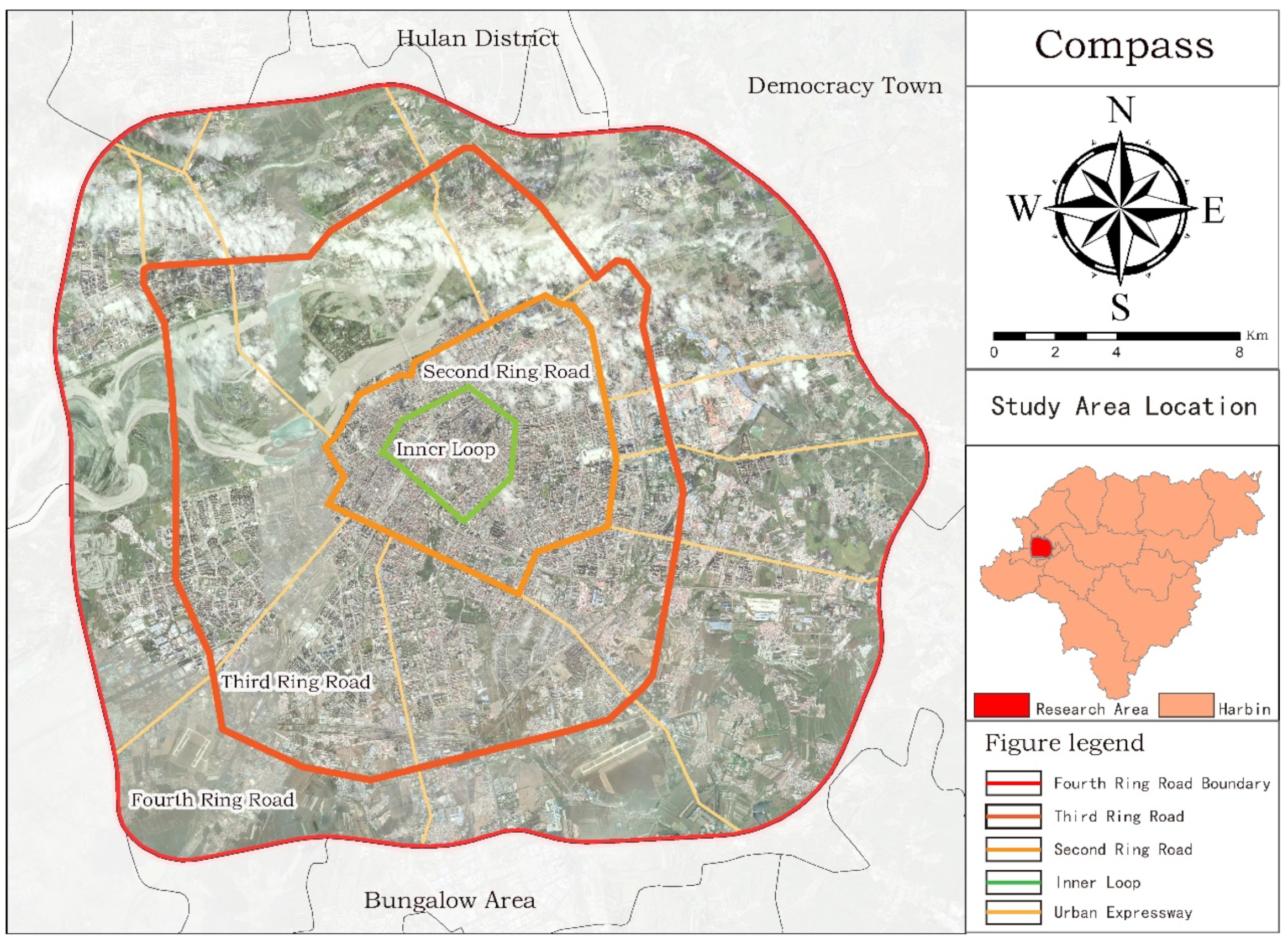
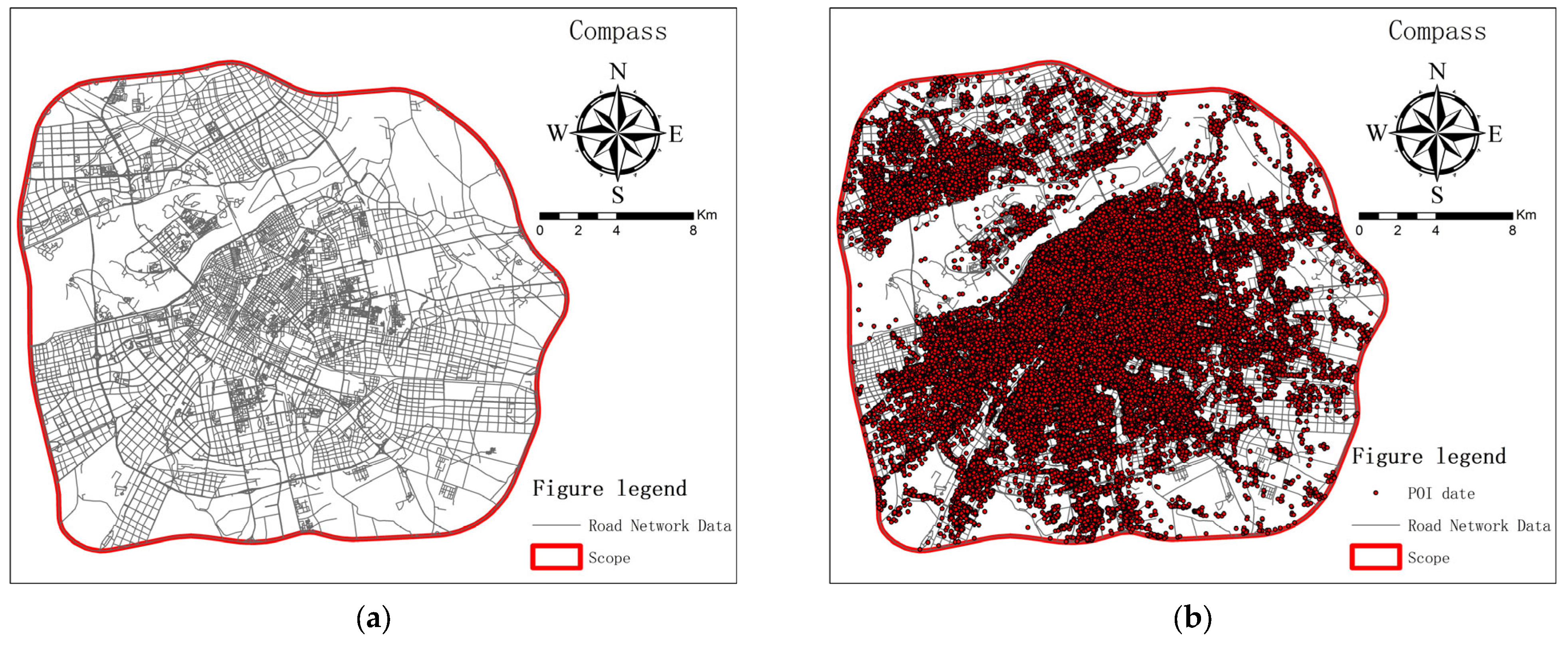

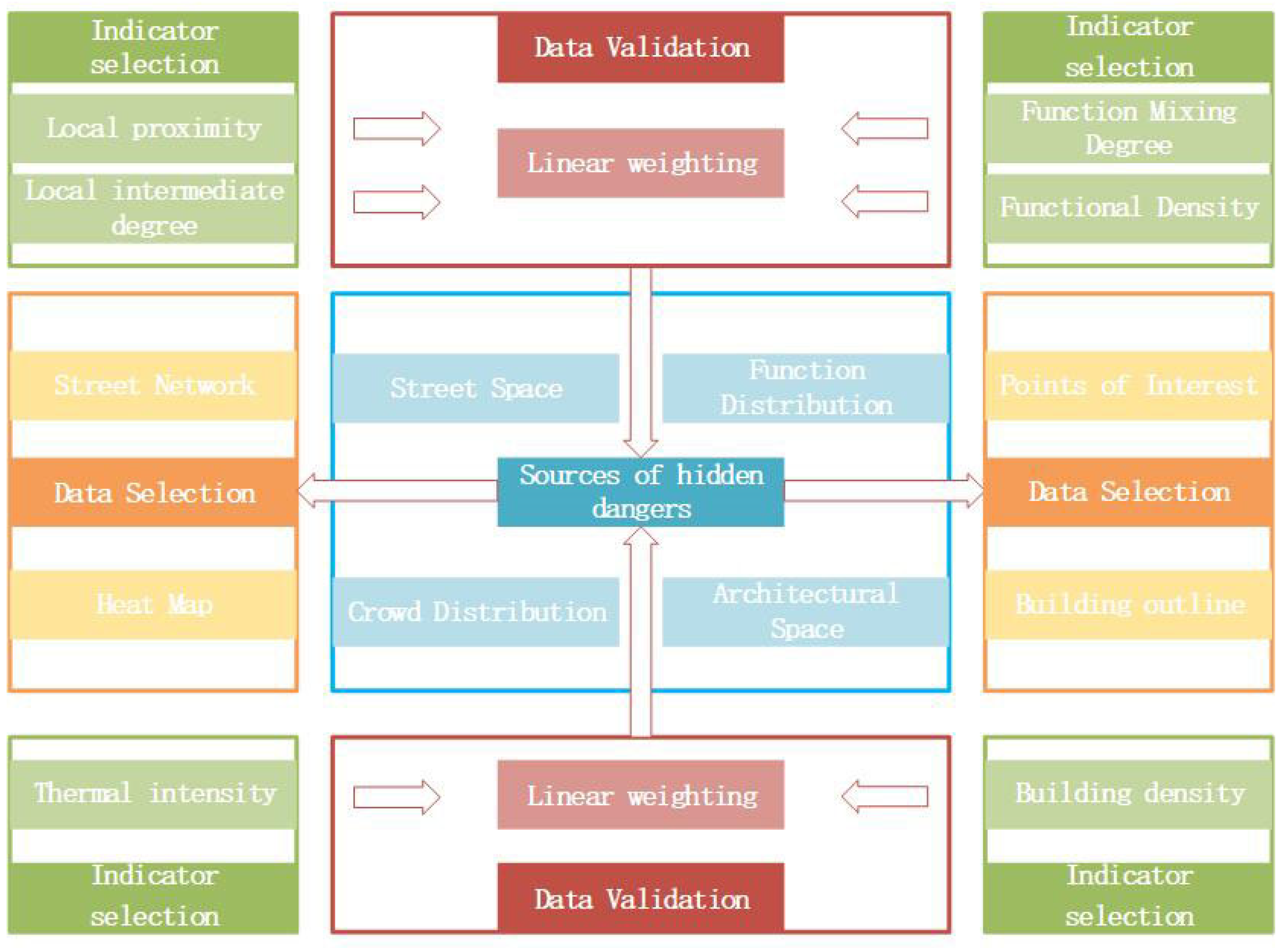
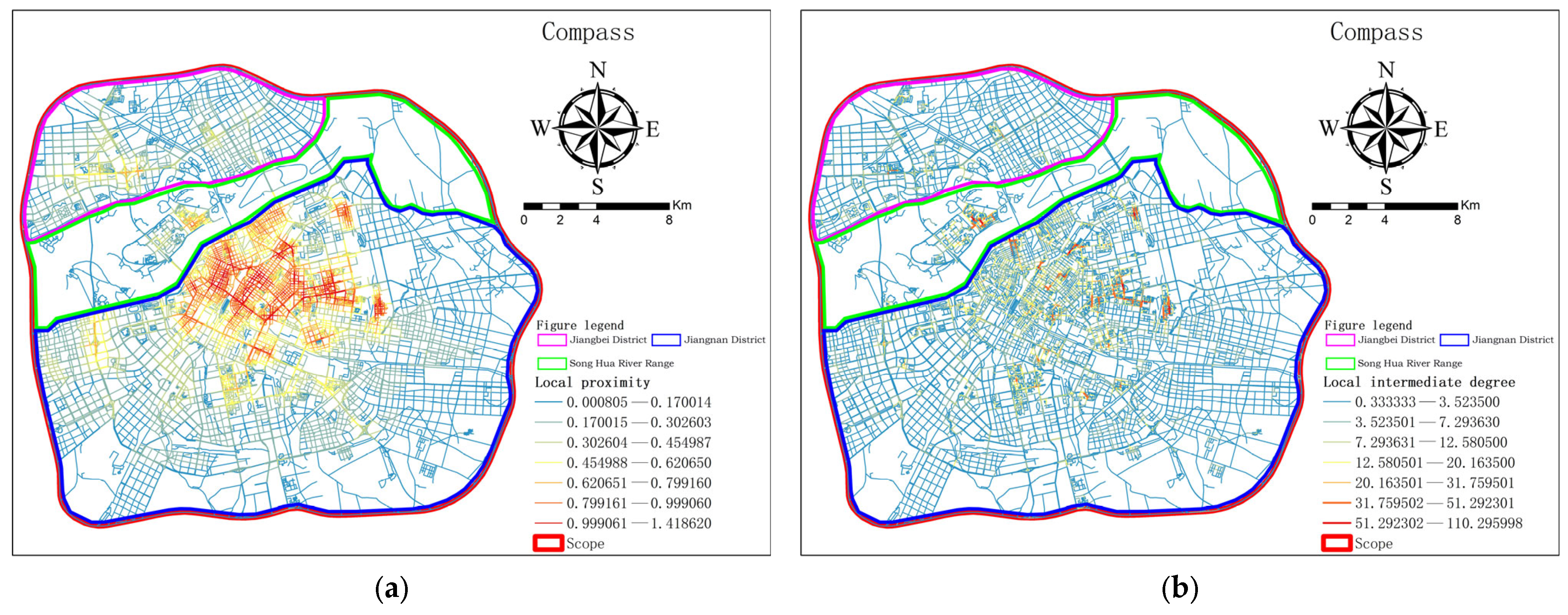
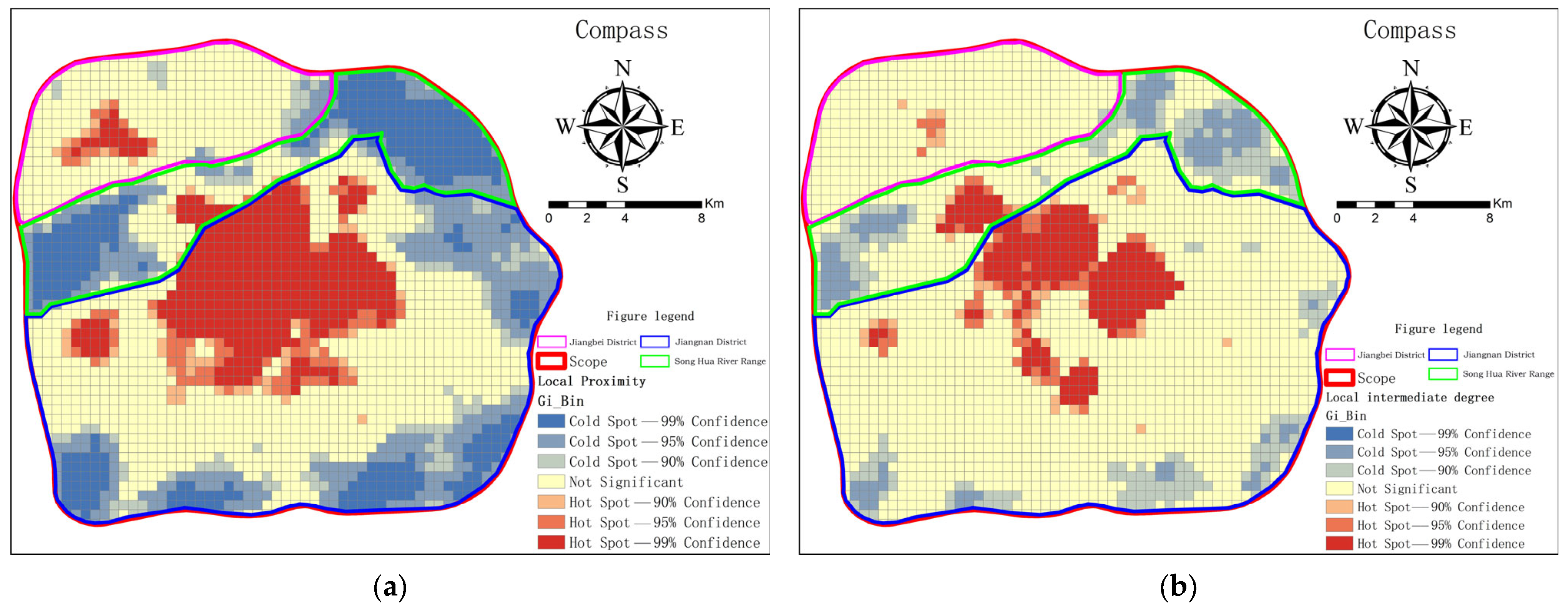
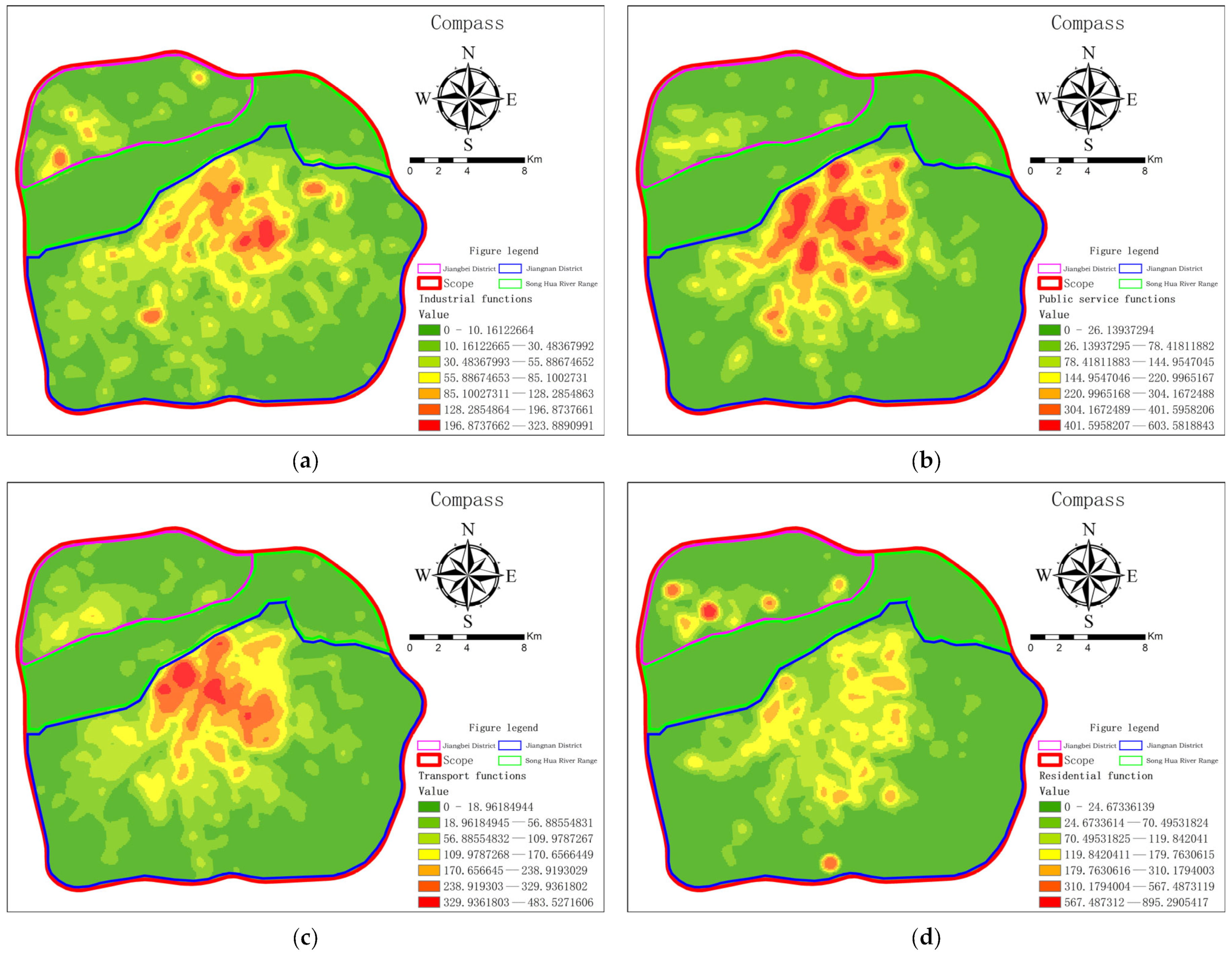
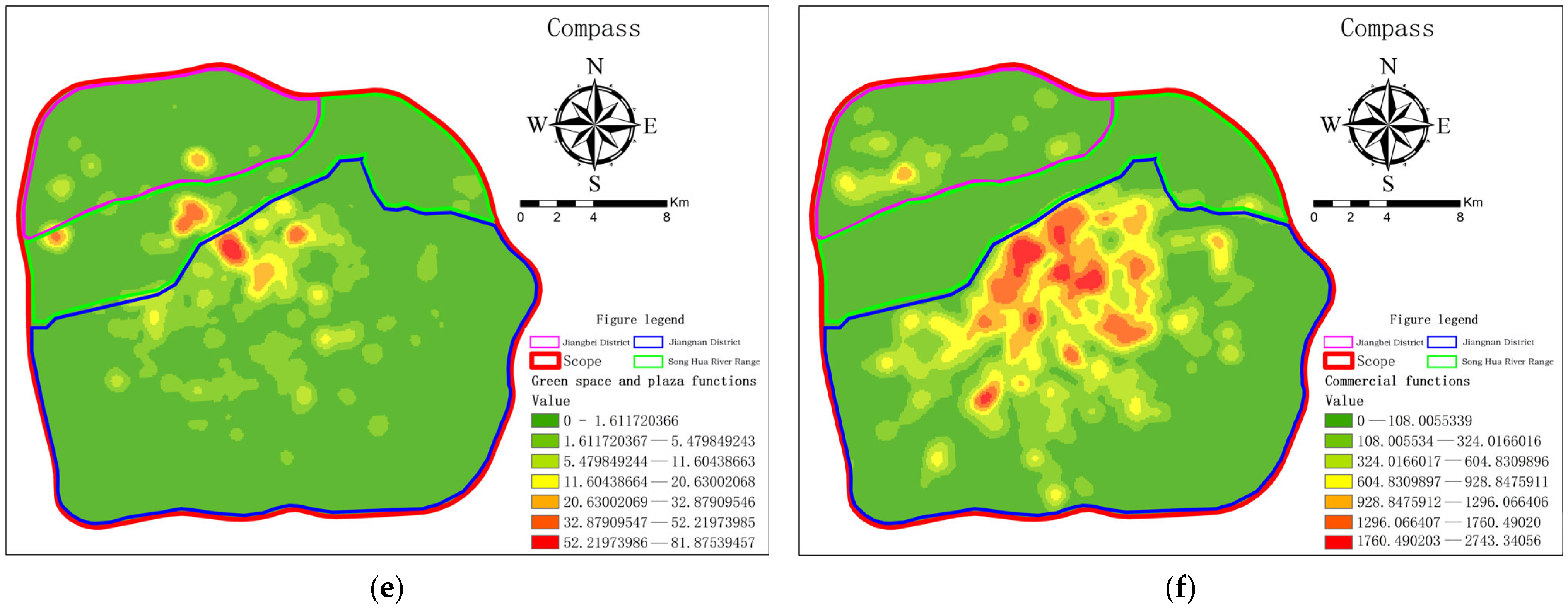
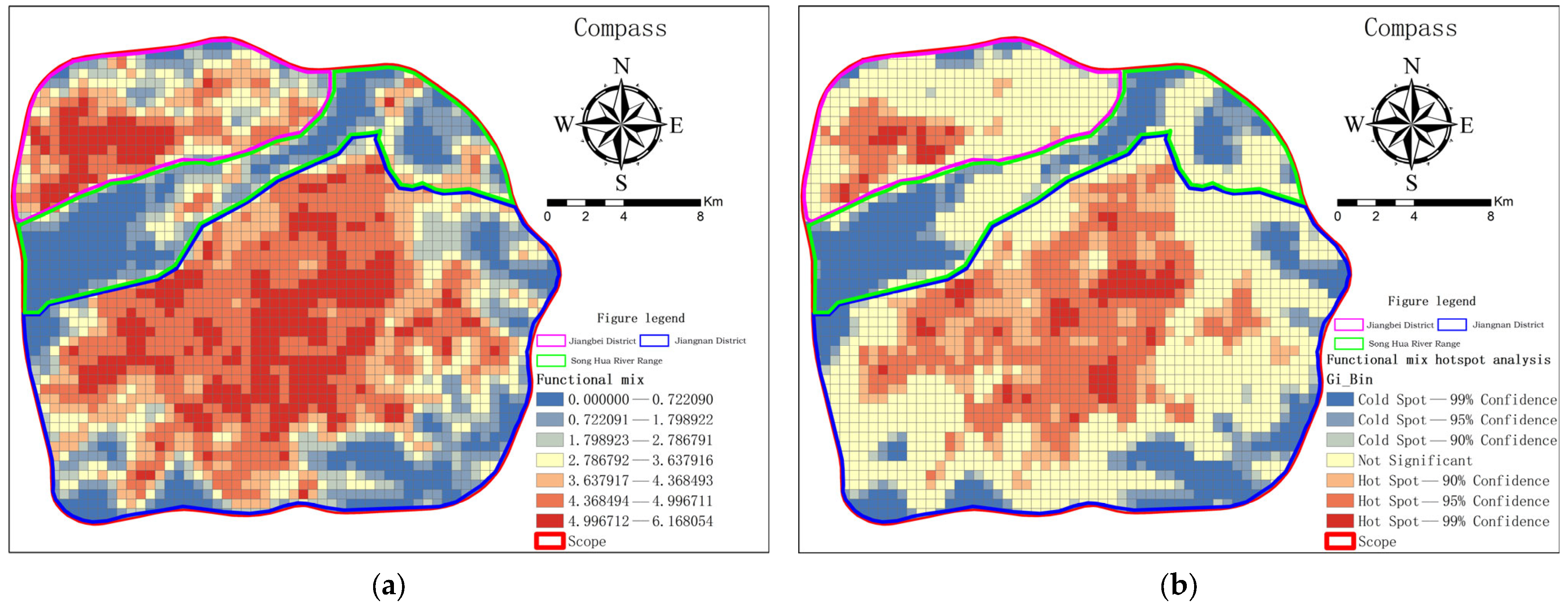
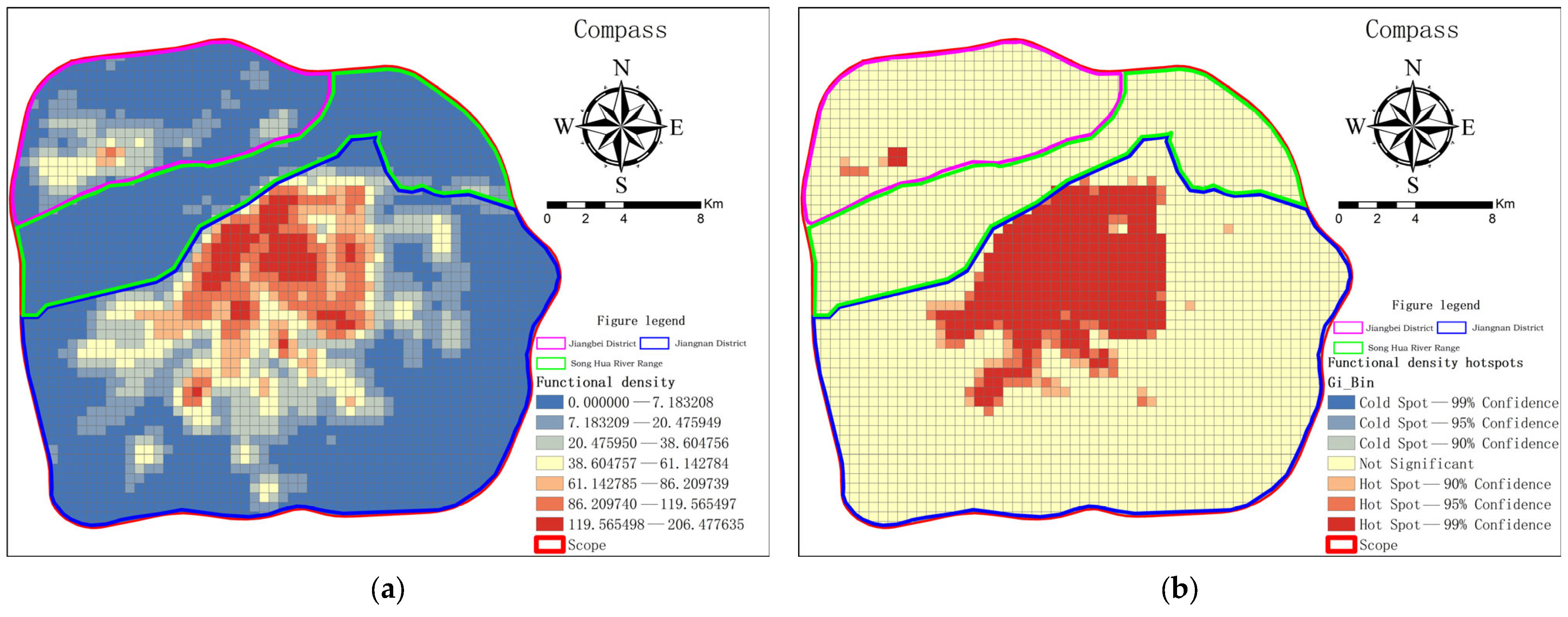
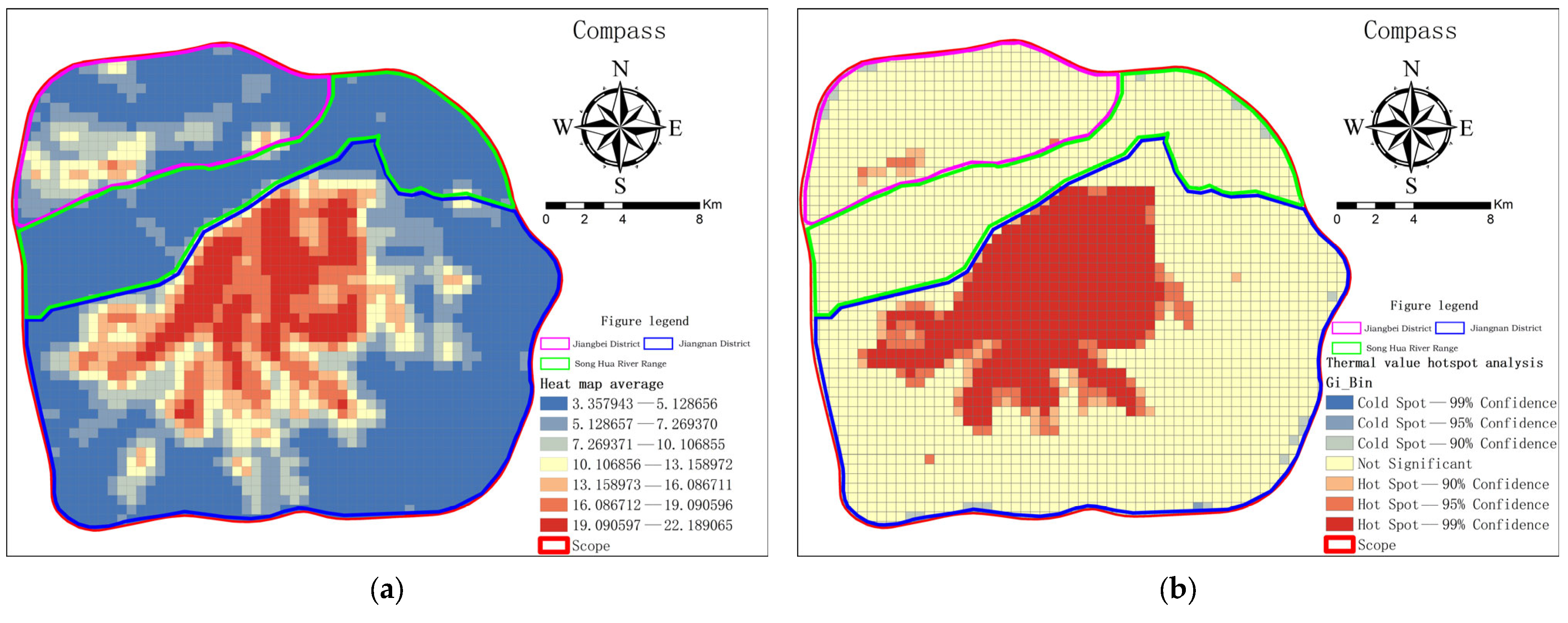
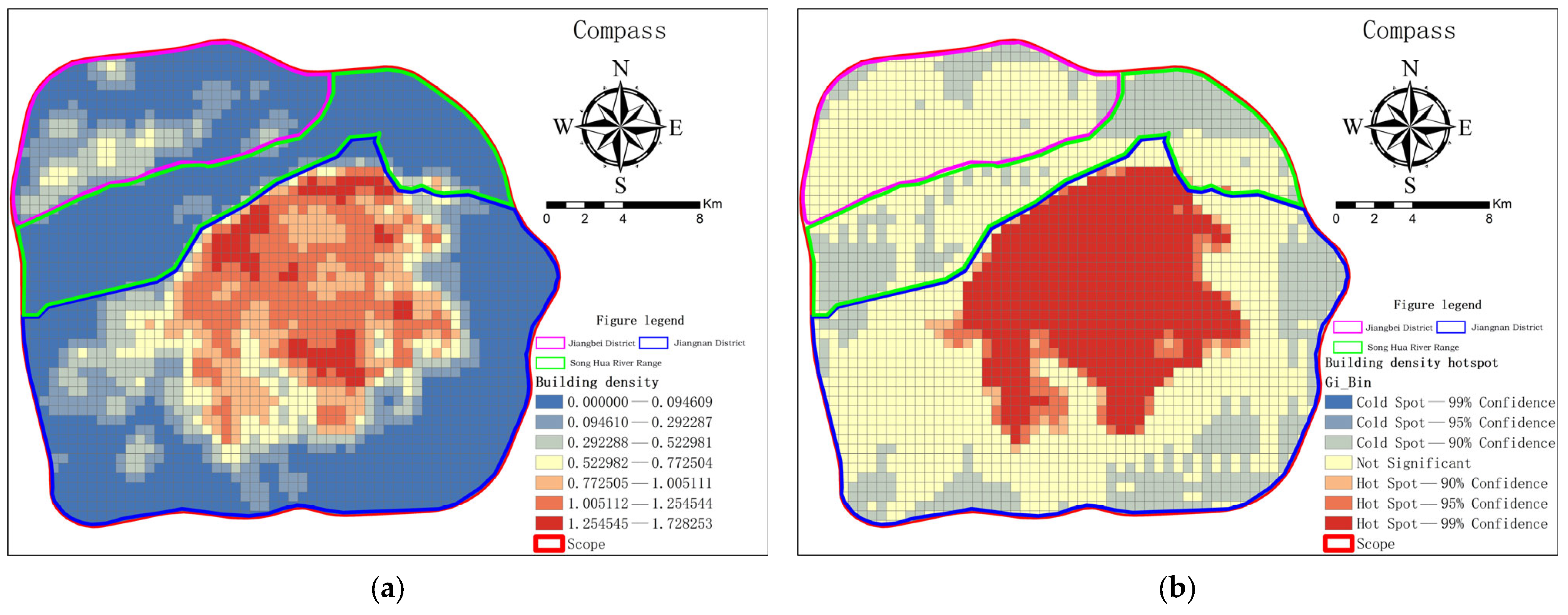
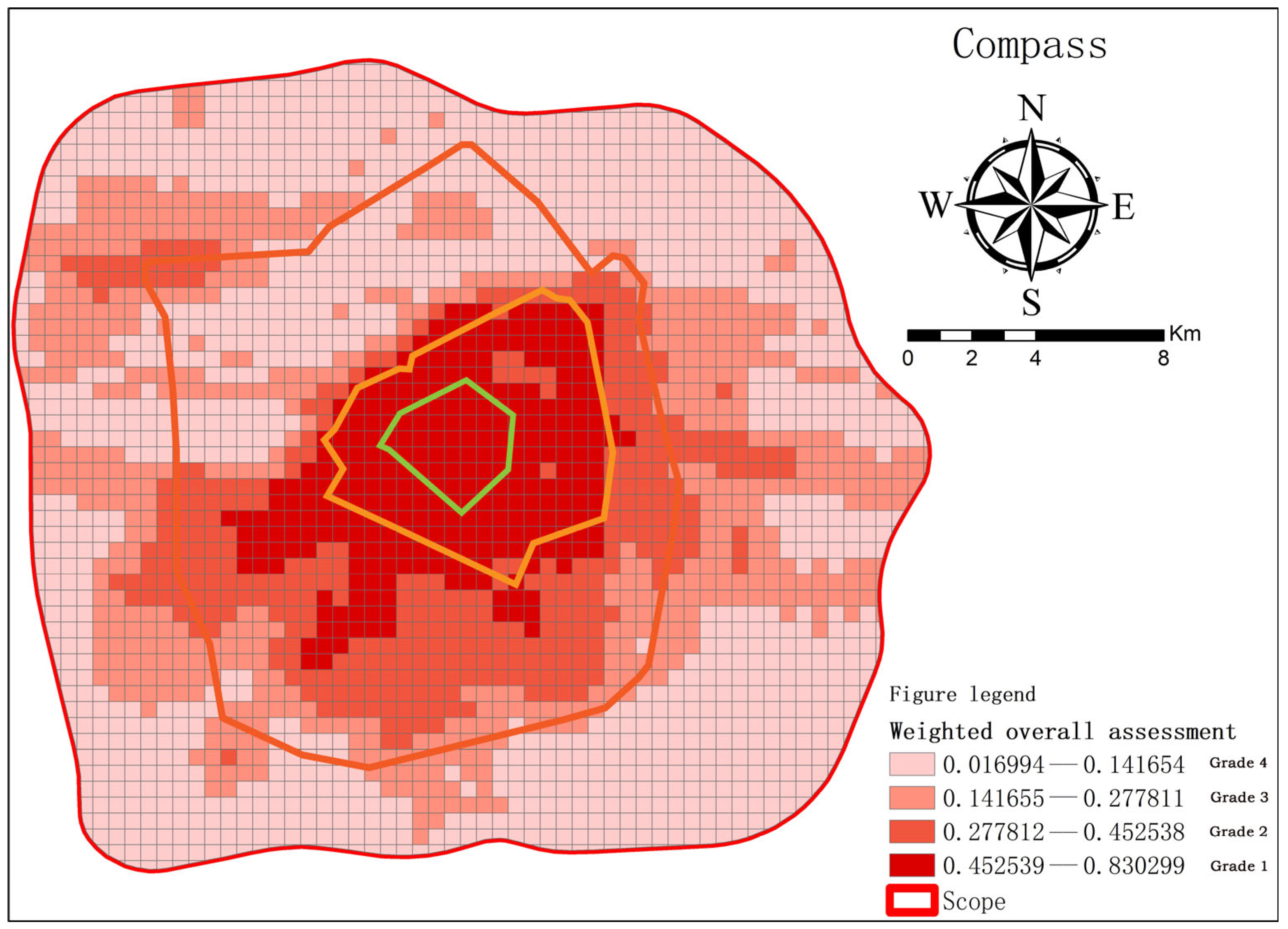
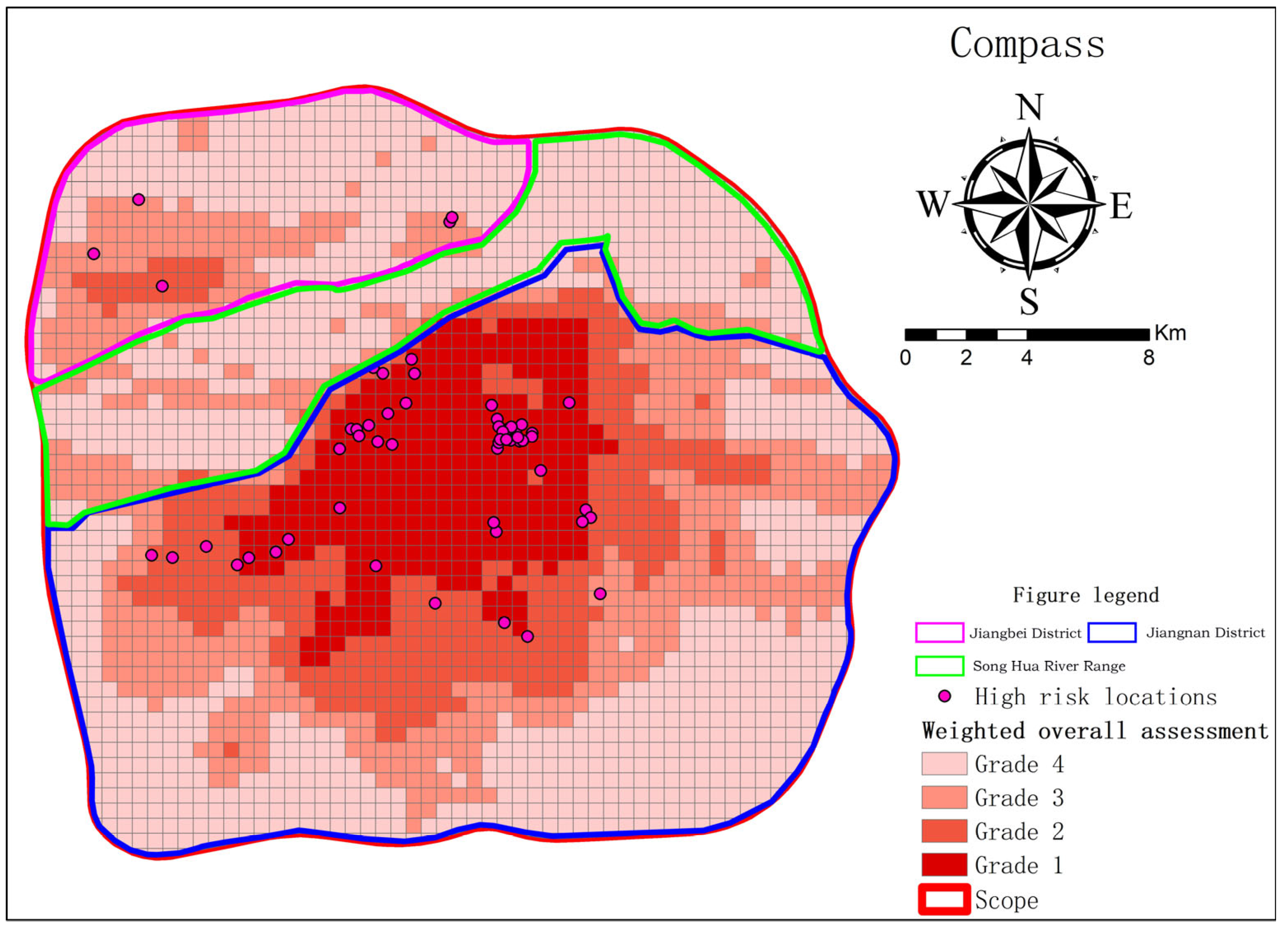
| Type | POI Quantity | Percentage (%) |
|---|---|---|
| Industrial function | 13,814 | 6.22% |
| Public Service Function | 35,624 | 16.03% |
| Traffic function | 26,297 | 11.82% |
| Residence function | 18,987 | 8.54% |
| Green space and square function | 905 | 0.41% |
| Business Function | 126,639 | 56.98% |
| Total | 222,266 | 100% |
| Indicator Items | Functional Mix | Functional Density | Proximity | Intermediate Degrees | Thermal Strength | Building Density |
|---|---|---|---|---|---|---|
| Weighs | 0.05 | 0.28 | 0.15 | 0.12 | 0.17 | 0.23 |
| Region | Songbei District | Nangang District | Xiangfang District | Daoli District | Daowai District |
|---|---|---|---|---|---|
| Number | 5 | 28 | 8 | 20 | 0 |
| Risk Areas | Songbei District | Nangang District | Xiangfang District | Daoli District | Daowai District | Total |
|---|---|---|---|---|---|---|
| Grade 1 | 0 | 24 | 4 | 15 | 0 | 45 |
| Grade 2 | 1 | 3 | 4 | 6 | 0 | 11 |
| Grade 3 | 4 | 0 | 0 | 0 | 0 | 5 |
Disclaimer/Publisher’s Note: The statements, opinions and data contained in all publications are solely those of the individual author(s) and contributor(s) and not of MDPI and/or the editor(s). MDPI and/or the editor(s) disclaim responsibility for any injury to people or property resulting from any ideas, methods, instructions or products referred to in the content. |
© 2023 by the authors. Licensee MDPI, Basel, Switzerland. This article is an open access article distributed under the terms and conditions of the Creative Commons Attribution (CC BY) license (https://creativecommons.org/licenses/by/4.0/).
Share and Cite
Sun, M.; Jiao, X. Quantitative Identification Study of Epidemic Risk in the Spatial Environment of Harbin City. Sustainability 2023, 15, 7558. https://doi.org/10.3390/su15097558
Sun M, Jiao X. Quantitative Identification Study of Epidemic Risk in the Spatial Environment of Harbin City. Sustainability. 2023; 15(9):7558. https://doi.org/10.3390/su15097558
Chicago/Turabian StyleSun, Ming, and Xueyu Jiao. 2023. "Quantitative Identification Study of Epidemic Risk in the Spatial Environment of Harbin City" Sustainability 15, no. 9: 7558. https://doi.org/10.3390/su15097558
APA StyleSun, M., & Jiao, X. (2023). Quantitative Identification Study of Epidemic Risk in the Spatial Environment of Harbin City. Sustainability, 15(9), 7558. https://doi.org/10.3390/su15097558





